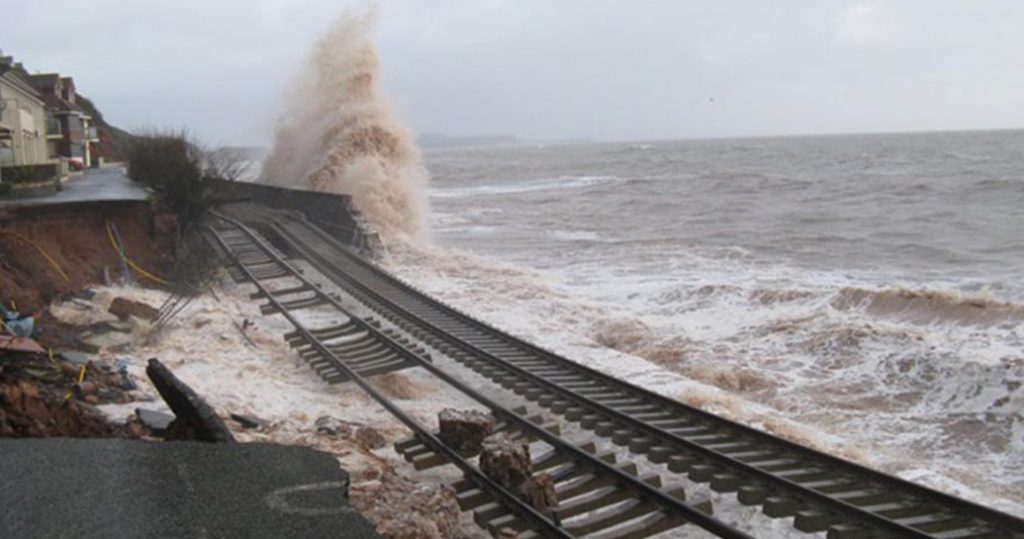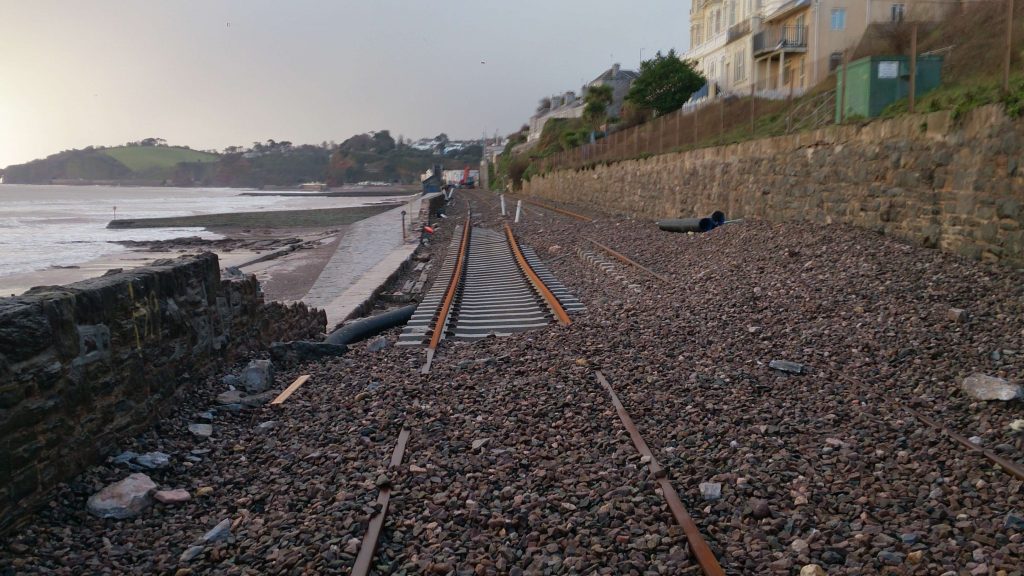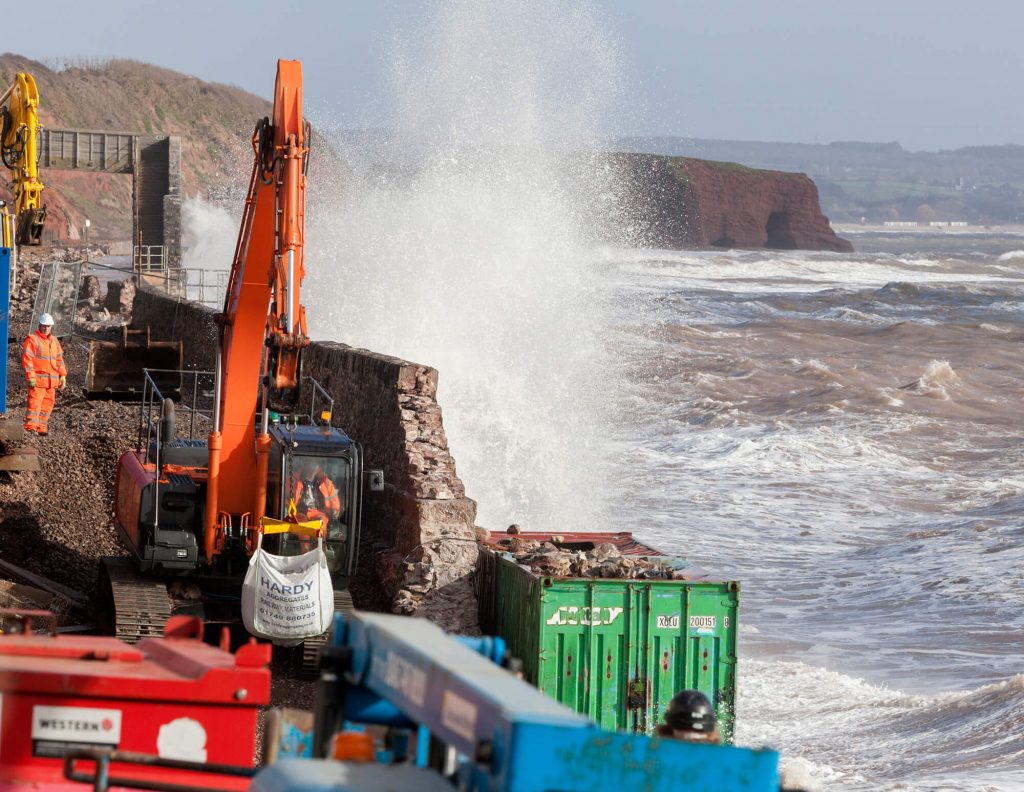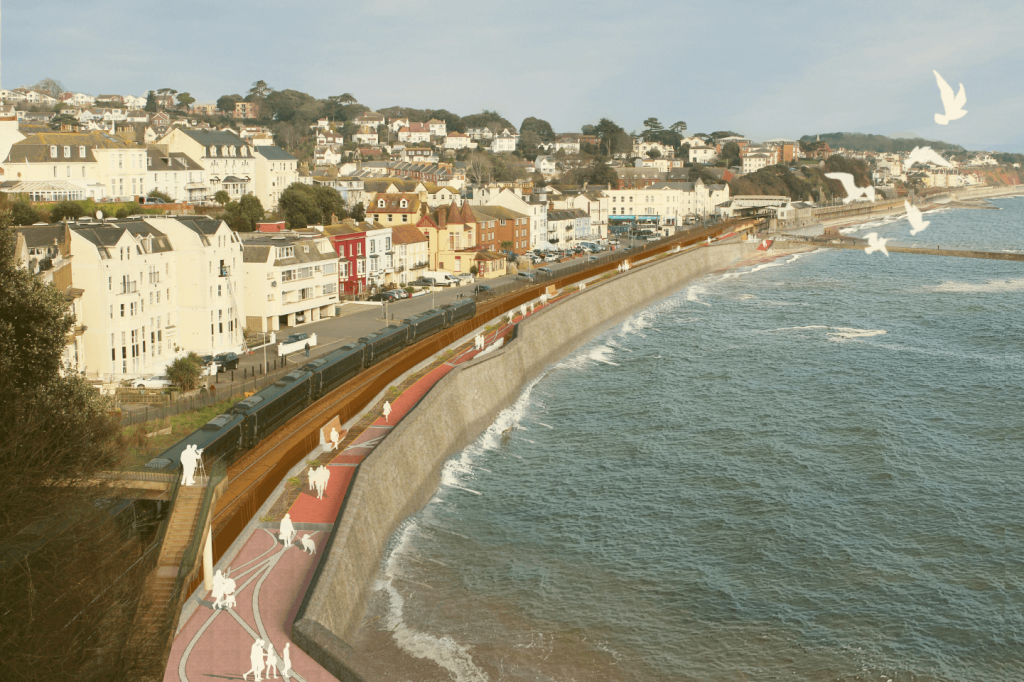Five years ago, we reopened a stretch of coastal railway that had collapsed into the sea – just eight weeks after the damage.
The severe weather of February 2014 cut off the South West peninsular from the rest of the railway; the mainline that runs through Dawlish in Devon is the only line connecting most of the county and all of Cornwall to the rest of the network.
Fast-pace repairs by 300 Network Rail engineers meant the line at Dawlish reopened just eight weeks later. How did we do it? Innovation, a controlled landslip and more than 6,000 tonnes of concrete.
Today, engineers are working on our South West Rail Resilience Programme to improve the resilience of the railway between Dawlish and Teignmouth in Devon.

Dawlish – damage in February 2014
World-leading experts in coastal, tunnel, cliff and railway engineering have carried out detailed studies on resilience in the area.
The research has helped us determine what is happening to the cliffs and coastline, so we can implement long-term solutions to protect the line and town from coastal erosion.
On 4 February this year, we said we had made a planning submission to Teignbridge District Council for a new, higher sea wall at Dawlish that would provide greater resilience for generations to come.
The 2014 damage caused significant disruption to residents, visitors and businesses that use and rely on the line. Our aim is to prevent similar incidents in the future.
Repairs by Network Rail continue a year following the storms…
What happened – storms hit Dawlish
Over 4 and 5 February 2014, very strong winds and high seas severely damaged the railway line that runs through Dawlish. The wall between the sea and the railway line breached; a section of the wall washed away, as did 80 metres of track, platforms at Dawlish railway station and sections of the coastal path.
Another storm on 14 February caused a breach of the temporary sea defences (a line of shipping containers). On 4 March, just around the coast near Teignmouth, a controlled landslip resulted in 20,000 tonnes of material being washed down from the cliff over the railway and into the sea.
Network Rail’s team of engineers battled for more than two months to overcome every obstacle thrown at it by Mother Nature as they worked to repair a 100-metre breach at Riviera Terrace in Dawlish.

Strong winds and rain at Dawlish in 2018
The 2014 response involved:
- Installing a temporary sea wall made from 19 welded shipping containers to prevent further damage
- Rebuilding and fortifying the breach with more than 6,000 tonnes of concrete and 150 tonnes of steel
- Removing 25,000 tonnes of collapsed cliff at Woodlands Avenue (the final estimate rose to about 100,000 tonnes), Teignmouth, following a landslip on 4 March 2014, using high pressure water cannon, fire hoses, helicopter-borne water bombs, specialist roped access team and ‘spider’ excavators
- Repairing dozens of other sites along a four mile stretch of coastal railway, clearing hundreds of tonnes of debris and repairing more than 600 metres of parapet wall
- Installing over 13 miles of new cables, designing and installing a new temporary signalling system and replacing more than 700 metres of track and ballast
- Extensively rebuilding and repairing much of Dawlish station with a new platform, new canopy and repainting throughout with the finishing touches provided by TV gardener, Toby Buckland, and members of the ‘Friends of Dawlish station’
With the most critical phase of the restoration complete and the line reopened in just two months, engineers moved to the less critical phase:

- Fully restoring the signalling and electronic equipment
- Removing the shipping container temporary sea wall
- Rebuilding Brunel’s original sea-wall at the breach site
- Restoring the public footpath on the seaward side of the sea wall
- Rebuilding the ‘lost road’ at Riviera Terrace
The new raised sea wall officially opened on 14 August 2015. It stretches continuously for four miles. The old seafront walkway was regularly cut off at high tide but the new one is protected from the sea and gives superb views along the coast.
We hope to build an even stronger wall for the next century
The design plans we have submitted will prevent stormy conditions from damaging the railway. High waves and strong winds regularly damage the tracks and the station.
Since the storms of 2014, we have established that maintaining the current railway route is the most feasible and cost-effective solution. As a result, we propose to build a new, higher and wider seawall in front of the existing wall. This will increase resilience from waves and extreme weather and take predicted rising sea levels into account.
The local community will also benefit from a wider, safer promenade which retains the views of the coast – a feature the area is famous for.
Mark Langman, managing director of the Western route at Network Rail, said: “Improving the resilience of the sea wall at Dawlish is one of the most immediate and easiest areas we can begin work on and we’ve now submitted detailed plans to Teignbridge District Council.”

Julie Gregory, senior commercial scheme sponsor at Network Rail, said the new wall would help us avoid disruption to train services following extreme weather.
She said: “The bit that’s most vulnerable is the bit we’re addressing first, to the West of Dawlish Station. That’s called Marine Parade and it’s about a 360m section of sea wall that we’re raising using pre-cast concrete panels. It will make the wall about 2.5m higher… We want to do the job once, shore up the railway to protect it through the next century, taking into account sea level rise as a result of climate change.”